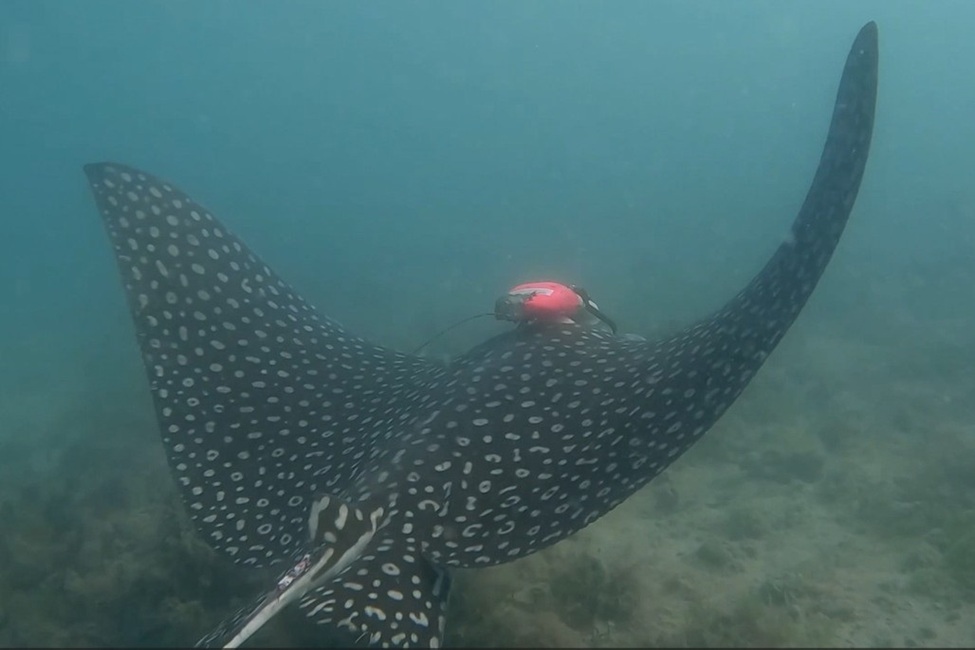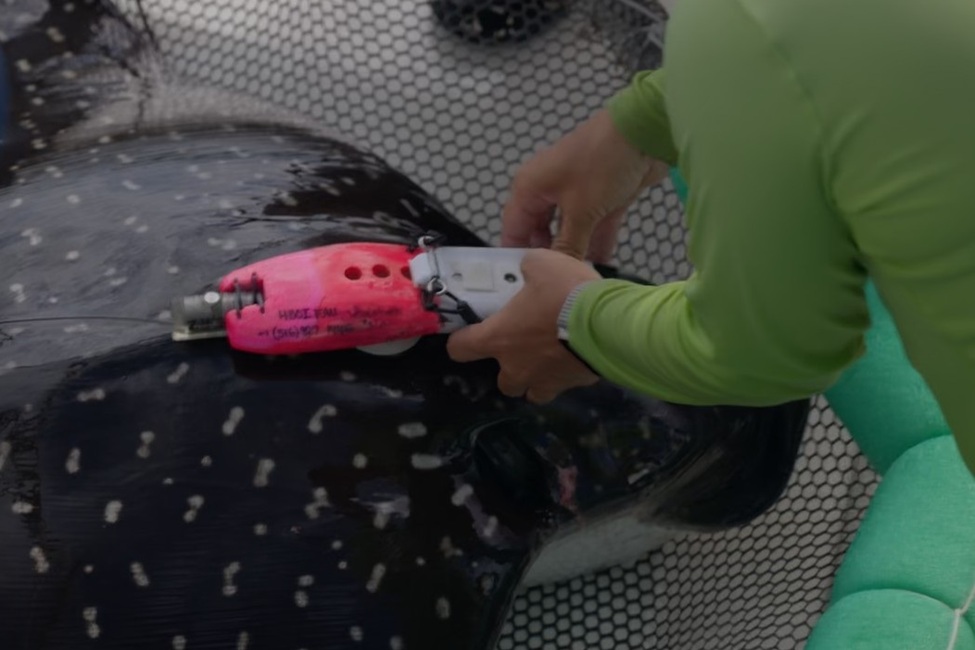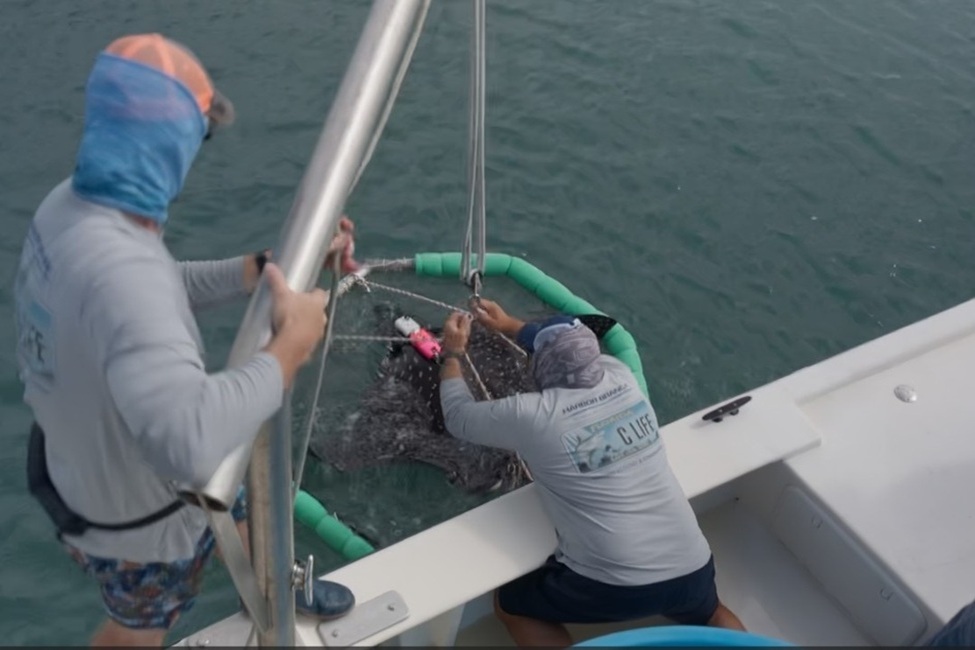Spying on Stingrays: First-ever Tags Show Elusive Behaviors, Habitats

A whitespotted eagle ray swims with the multi-sensor tag.
Biologging – an innovative, non-invasive method of tracking animals in the wild – is transforming how scientists study movement, behavior and social interactions. Using compact electronic devices that can remain attached for hours or even months, researchers can now gather detailed data with minimal disruption to the animals’ natural lives.
Although biologging has been widely applied to marine mammals such as turtles and sharks, skates and stingrays (batoids) have been overlooked. This oversight is concerning, as many batoid species are increasingly at risk of extinction yet play critical roles in marine food webs. However, their behavior remains poorly understood – largely because studying them in the wild has been so challenging. For example, one major challenge is their unique body shape: unlike sharks, rays lack a prominent dorsal fin, and some species have ultra-smooth skin, making it difficult to attach tracking devices securely.
Researchers from Florida Atlantic University’s Harbor Branch Oceanographic Institute are the first to successfully develop and field-test a multi-sensor biologging tag on the elusive whitespotted eagle ray (Aetobatus narinari), a species found in tropical and subtropical coastal waters.
Feeding primarily on hard-shelled prey such as clams and conch, this large, powerful predator can grow more than 2 meters (6.5 feet) in wingspan and weigh several hundred kilograms. Although known for long-distance migrations, they often linger in coastal habitats and lagoons, making them an ideal candidate to test the new biologging technology.
The study findings, published in the journal Animal Biotelemetry, demonstrate that the tag’s innovative design enabled it to remain securely attached even in strong currents. This resulted in the longest documented attachment times for external tags on pelagic rays – lasting up to 60 hours. This is the first time a biologging system like this has been successfully used on a stingray species that feeds on hard-shelled prey.
“These animals are powerful, fast-moving and live in dynamic, high-energy environments, which makes tagging them a real challenge,” said Matt Ajemian, Ph.D., senior author, an associate research professor and director of the Fisheries Ecology and Conservation Lab (FEC) at FAU Harbor Branch. “Our goal was to create a system that could be applied in seconds, stay on during natural behaviors, and collect rich, multi-dimensional data. We’re now able to observe not just where these rays go, but how they feed, how they move through their habitats, and how they interact with other species – insights that were virtually impossible to capture before.”
The custom-built tag integrates a motion sensor, video camera, underwater microphone, satellite transmitter and acoustic tracker – all within a compact, lightweight design. These tags are engineered to capture detailed feeding behaviors, with particular attention to interactions involving armored prey.
A key innovation is the fast, minimally-invasive attachment system, which uses silicone suction cups and specially designed straps secured near the ray’s spiracles (the small openings just behind the eyes). The design and implementation of the spiracle straps significantly increased retention and is likely applicable to other similar species of rays.
“Our work marks a turning point in how we study elusive marine species like pelagic rays,” said Cecilia M. Hampton, corresponding author and a Ph.D. student in the FEC lab at FAU Harbor Branch. “We’ve shown that complex behaviors – like the crunching of clams – can be identified using sound and movement data alone, even without video. This opens up exciting possibilities for long-term ecological monitoring using simpler, more efficient tags. It’s not just about observing feeding – we’re beginning to map out entire behavioral landscapes, from foraging strategies to social dynamics. These insights are vital for understanding how rays respond to environmental change and how best to protect them.”
To pinpoint key movement signals that predict these behaviors, researchers used a supervised machine learning method called a Random Forest model. They trained the model on data from one tagged ray, with two reviewers first labeling behaviors – “swimming,” “browsing” and “digging” – by reviewing video footage. The model predicted foraging behavior well, which paves the way for more accessible and smaller tags to be used in the future for the same performance. More data from varied locations will help further develop these relationships.
Looking ahead, the researchers say their tagging system could be adapted to other ray species, with slight modifications to account for differences in body size and spiracle shape.
“As biologging technologies advance, combining data streams like movement, sound and video – and applying machine learning for behavior classification – could turn rays into mobile surveyors of ocean health and benthic habitats,” Ajemian said.
Study co-authors are Breanna C. DeGroot, State College of Florida; Lauran Brewster, Ph.D., School for Marine Science & Technology, University of Massachusetts, Dartmouth; Kim Bassos-Hull, Ph.D., Sharks & Rays Conservation Program, Mote Marine Laboratory; Benjamin A. Metzger, FAU Harbor Branch; and T. Aran Mooney, Biology Department, Woods Hole Oceanographic Institute.
This work was supported by the National Science Foundation and Harbor Branch Oceanographic Institute Foundation.
//
Researchers placed a multi-sensor tag on a whitespotted eagle ray and captured where they go, how they feed, how they move through their habitats, and how they interact with other species – insights that were virtually impossible to capture before. (Video credit: FAU Harbor Branch, Cecilia Hampton and Kyle Newton)

Researchers place the multi-sensor tag on a whitespotted eagle ray. (Photo credit: Kyle Newton)

Researchers release a whitespotted eagle ray fitted with the multi-sensor tag. (Photo credit: Kyle Newton)
-FAU-
Latest News Desk
- Discovery to Display: FAU Unveils the 'Art of Science' WinnersFAU's Art of Science showcases stunning research-inspired images submitted by students, faculty and staff. Explore more than 200 entries and vote for your favorite in the People's Choice Award.
- FAU Secures $1.4 Million Grant to Save Wildlife in Florida EvergladesFAU's Charles E. Schmidt College of Science has received a U.S. Army Corps of Engineers grant to study dry-season prey in the Everglades and its impact on wading bird nesting success and ecosystem restoration.
- Gutterman Center for Holocaust and Human Rights Honors EducatorsFlorida Atlantic University's Arthur and Emalie Gutterman Center for Holocaust and Human Rights Education (CHHRE) recently hosted its annual Educator Awards Dinner at the Boca Raton Marriott at Boca Center.
- FAU College of Business to Host Boca Finance & Real Estate ConferenceFAU's College of Business will host a specialized conference and networking event to offer an inside look at the future of finance and real estate as South Florida accelerates its rise as "Wall Street South."
- FAU's CAROSEL Offers New 'Spin' on Real-Time Water Quality MonitoringFAU Harbor Branch's CAROSEL is an autonomous underwater system that tracks nutrient exchanges between sediments and water in real time, revealing impacts on water quality and ecosystem health.
- FAU Engineering Receives $1.5M to Launch Ubicquia Innovation CenterThe Ubicquia Innovation Center for Intelligent Infrastructure will drive sensor, AI and analytics innovation to digitize and monitor infrastructure across utility, municipal, commercial and industrial sectors.






